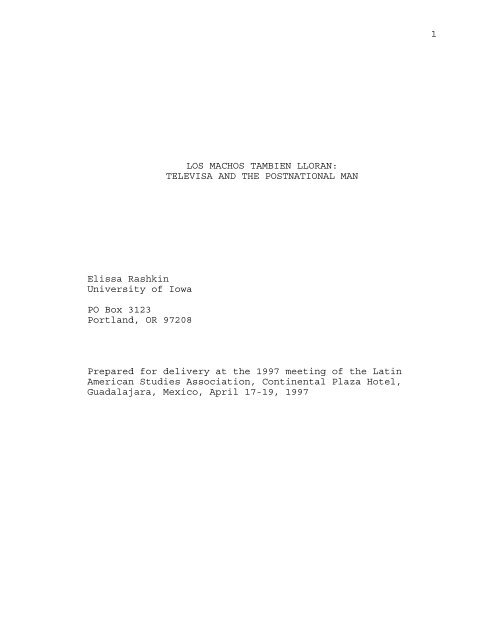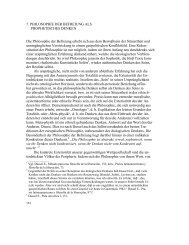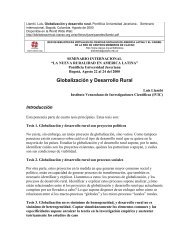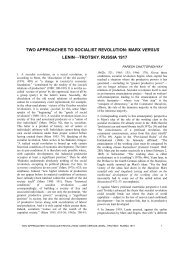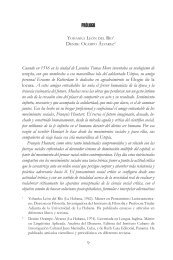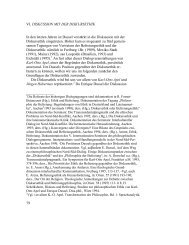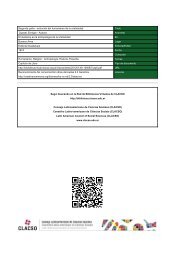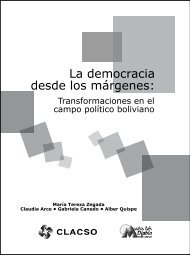1 LOS MACHOS TAMBIEN LLORAN: TELEVISA AND ... - CLACSO
1 LOS MACHOS TAMBIEN LLORAN: TELEVISA AND ... - CLACSO
1 LOS MACHOS TAMBIEN LLORAN: TELEVISA AND ... - CLACSO
You also want an ePaper? Increase the reach of your titles
YUMPU automatically turns print PDFs into web optimized ePapers that Google loves.
Elissa Rashkin<br />
University of Iowa<br />
PO Box 3123<br />
Portland, OR 97208<br />
<strong>LOS</strong> <strong>MACHOS</strong> <strong>TAMBIEN</strong> <strong>LLORAN</strong>:<br />
<strong>TELEVISA</strong> <strong>AND</strong> THE POSTNATIONAL MAN<br />
Prepared for delivery at the 1997 meeting of the Latin<br />
American Studies Association, Continental Plaza Hotel,<br />
Guadalajara, Mexico, April 17-19, 1997<br />
1
<strong>LOS</strong> <strong>MACHOS</strong> <strong>TAMBIEN</strong> <strong>LLORAN</strong>:<br />
<strong>TELEVISA</strong> <strong>AND</strong> THE POSTNATIONAL MAN<br />
Scholars writing about constructs and practices of gender,<br />
family and sexuality have concurred that male adultery and<br />
polygamy have a long history in Mexico, as elsewhere in the<br />
world. Contributors to the volume Presencia y transparencia: La<br />
mujer en la historia de México give us a picture of the evolution<br />
of the so-called "casa chica" over five centuries. Analyzing the<br />
fragmentary but nonetheless enlightening texts left by the<br />
Mexicas, María de Jesús Rodríguez finds that among Aztec<br />
nobility, marriage was used primarily to form political<br />
alliances, but that female concubines could be chosen across<br />
class lines. While monogamy was more standard for the lower<br />
classes, men, especially warriors, were still permitted to take<br />
lovers and consort with prostitutes. Female chastity, on the<br />
other hand, was enforced by both religious fear and severe<br />
secular penalties, including death (28).<br />
Polygamy, like human sacrifice, was abhorrent to the<br />
Europeans who arrived bearing Catholic ideology along with their<br />
other weapons of domination. Yet the church's imposition of<br />
monogamy during the colonial period, argues Pilar Gonzalbo, meant<br />
little more in practice than the economic abandonment of many<br />
women; polygamous relationships continued to exist, but their<br />
deinstitutionalization freed men from responsibility (44). In New<br />
Spain, as Françoise Carner points out, adultery was considered an<br />
"essentially feminine sin," threatening to the social order when<br />
committed by women, but rarely condemned in men (98-99). This<br />
view did not change with Independence. In their study of<br />
campesina women and violence at the turn of the century, Soledad<br />
González and Pilar Iracheta found that the law was easier on<br />
women in regard to capital crimes, but harsher in cases of<br />
adultery, sexual offenses and abandonment (120). In the home,<br />
women were often beaten for adultery, but also for denouncing<br />
their husbands' infidelity, and betrayed wives were more likely<br />
to confront their rivals than the husband himself, implying the<br />
essential innocence, or invulnerability, of the male perpetrator<br />
(132).<br />
Although the double standard may not be so pronounced today,<br />
recent ethnographic studies, such as those Ruth Behar and Sarah<br />
LeVine conducted among poor women in San Luis Potosí and Morelos,<br />
attest to the persistence of polygamous relations in contemporary<br />
society. LeVine writes of newly married couples in the Cuernavaca<br />
community of Los Robles that "both take the wife's fidelity as a<br />
given," whereas "even teenage husbands bragged about extramarital<br />
affairs, real or imagined" (87). At the other end of the social<br />
2
spectrum, presidential mistress-turned-senator Irma Serrano wrote<br />
in her 1978 autobiography about the double standard from the<br />
point of view of "la otra": "Con este tipo de amantes, no tiene<br />
una le privilegio de ir al cine o al teatro colgada de su brazo.<br />
Si acaso te acompañan a ver la television a ratitos, si bien te<br />
va....Para estos funcionarios somos un objeto, una bacinica"<br />
(139). If Serrano's account is representative, sexual infidelity<br />
was as natural a part of political office in post-Revolutionary<br />
administrations as it was in Aztec times.<br />
While this situation is in no way unique to Mexico, it does<br />
cause one to wonder: how, if the institution known as the "casa<br />
chica" or "segundo frente" is so widespread as to be banal, did<br />
it come to be the defining plot dilemma of one of the top<br />
telenovelas of the 1990s? Why did millions of viewers on both<br />
sides of the US/Mexico border in 1994 tune in to watch<br />
protagonist Juan Daniel/Johnny agonize night after night over the<br />
impossible decision between his wife and his girlfriend on the<br />
hit Televisa show Dos mujeres, un camino?<br />
My presentation today is not so much an answer to that<br />
question as a meditation on the mass culture representation of<br />
male identity in the era of the North American Free Trade<br />
Agreement, using Dos mujeres as a case study. I will argue that<br />
Juan Daniel's inability to successfully keep up his "segundo<br />
frente" is just one of the crises of masculinity figured in Dos<br />
mujeres, and that those crises, along with the show's<br />
geographical placement in Mexico City and Tijuana, drug traffic<br />
subplot, and alteration of conventional soap opera salvational<br />
mechanisms, make it more symptomatic of its time than many<br />
similar programs--make it, in fact, the NAFTA novela par<br />
excellence. The breakdown of machista values, such that male<br />
infidelity is a dilemma that results in tragedy rather than<br />
simply being concealed or forgiven, is exacerbated by the show's<br />
casting of New York Puerto Rican actor Erik Estrada in the lead<br />
role; for as I will argue, the border-crossing Estrada, even more<br />
than his hapless truck driver character on the show, is the ideal<br />
anti-hero of what Néstor García Canclini calls the "postnational"<br />
era.<br />
I. ¿Qué de raro tiene?: Machismo and Postnacionalismo<br />
In a 1993 essay entitled "¿Habrá cine latinoamericano en el<br />
año 2000?: La cultura visual en la época de postnacionalismo,"<br />
García Canclini writes that during the first half of this<br />
century, radio and cinema in Mexico served a unifying function,<br />
conflating disparate social groups and geographic regions into a<br />
nationally- defined totality. In the turbulent 1960s, the mass<br />
media, including advertising and television, continued to uphold<br />
the government's economic/ideological project of modernization<br />
and industrial development. In the 1990s, however, the<br />
3
transnationalization of economies has radically transformed the<br />
conditions of cultural production. García Canclini thus asks,<br />
¿Qué puede quedar de las identidades nacionales en un<br />
tiempo de globalización e interculturalidad, de<br />
coproducciones multinacionales y Cadenas de las<br />
Américas, de acuerdos de libre comercio e integraciones<br />
regionales, donde los mensajes, los artistas y los<br />
capitales atraviesan constantamente las fronteras?<br />
[...] ¿Pueden ser aún el arte y las comunicaciones<br />
masivas escenarios de la identidad nacional? (28)<br />
His own response would appear to be negative; for the<br />
privatization of communications (which has only intensified in<br />
the four years since the publication of his article) has favored<br />
the domination of U.S.-produced and controlled programming, and<br />
more generally has tended to displace old issues of national<br />
identity in the process of reducing everything to the purely<br />
mercantile (30). As promising exceptions to this rule, he cites<br />
the films La tarea, La mujer de Benjamín, and El bulto (32), yet<br />
one is left wondering what sorts of questions emerge, however<br />
inadvertently, in the transparently commercial forms of<br />
production that García Canclini dismisses. For just as the<br />
commercialization of fiestas and handicrafts that he brilliantly<br />
analyzed in his study Transforming Modernity are not simply<br />
registered as decline or absence but also constitute significant<br />
practical modifications of the lives and welfare of indigenous<br />
communities, so too might the much-abhorred Televisa provide a<br />
window, however opaque and distorted in execution, on changes<br />
taking place in Mexican society today.<br />
Let us return to the issue of machismo, a case in point. As<br />
scholars such as Charles Ramírez Berg, Jean Franco, and Ilene<br />
O'Malley have made clear, machismo is not synonymous with<br />
patriarchy, but rather represents a complex of cultural codes, a<br />
particular construct of masculinity that is intimately linked<br />
with the auto-definition, or historia patria, of the Mexican<br />
state, particularly since the Revolution. O'Malley argues that<br />
the figure of the mythic macho hero became a site in which the<br />
contradictions of the Revolution could be symbolically resolved<br />
and its failures glossed over. Franco points out the consequences<br />
of this symbolic construct for women:<br />
[T]he Revolution with its promise of social<br />
transformation encouraged a Messianic spirit that<br />
transformed mere human beings into supermen and<br />
constituted a discourse that associated virility with<br />
social transformation in a way that marginalized women<br />
at the very moment when they were, supposedly,<br />
liberated. (102)<br />
4
While the macho "superman" was an ambivalent and<br />
contradictory figure in novels of the Revolution (e.g. Los de<br />
abajo, Vámonos con Pancho Villa), he became the unqualified hero<br />
of the Mexican cinema. 1 Discussing the comedias rancheras and<br />
provincial melodramas of the 1930s through 1970s, Ramírez Berg<br />
writes about how "the charro hero, the macho ethos, and national<br />
ideals came together to produce a male image that came to stand<br />
for the nation's [image]....Macho is Mexico incarnate" (99-100).<br />
Machismo, as expressed in the cinema, oscillates between the<br />
poles of hero and outlaw; at times it may signify honor and<br />
pride, but just as often it places masculinity and brute power<br />
above conventional distinctions of right and wrong. Ramírez Berg<br />
cites a scene from the 1975 film El rey, in which an outsider<br />
asks a villager why the Robin Hood-like outlaw played by Antonio<br />
Aguilar is held in such respect; the villager replies, "The<br />
people know that he robs. Like a woman feels when her man beats<br />
her, she admires him for how well he hits her." Ramírez Berg goes<br />
on to speculate, "no doubt the PRI, the ruling party, traces its<br />
mythological origins to Aguilar's charro hero" (102).<br />
In the 1970s and 1980s, however, the sociopolitical<br />
foundations of machismo began to fall apart, due to both the<br />
changing role of women in national society and to the crippling<br />
economic crises that followed the post-Revolutionary "miracle"<br />
era, which weakened the notion of a unified state and thus the<br />
identity of the macho as exemplary Mexican. As the cherished<br />
goals and principles of the Revolution, however incompletely<br />
addressed in previous decades, finally collapsed under the weight<br />
of an obscene foreign and domestic debt, so too did the<br />
patriarchal hero, mythic creation of the Revolution, begin to<br />
seem antiquated and unequipped to face the new situation.<br />
Although the technocrats that emerged to guide Mexico in finding<br />
its place in the new world order can be seen as benefiting from<br />
the same patriarchal privilege that produced and protected their<br />
predecessors, the link between gender/sexuality and political<br />
power is no longer glorified, and the machista attitude has come<br />
to signify not virility but intransigence and self-destruction.<br />
This does not mean, of course, that current mass culture is<br />
more progressive than in the past. A casual glance at any<br />
telenovela or other program or commercial artifact will show that<br />
contemporary fare is far from feminist, and in fact adheres to<br />
antiquate moral notions about sexuality which categorize women as<br />
either virgins or whores, even as it simultaneously profits from<br />
the exploitation of "liberated" female bodies as sexual objects-objects<br />
of the gaze and of consumption. While telenovelas and<br />
other entertainment aimed at women continue to encourage passive<br />
Cinderella fantasies, popular music tends towards fatalism,<br />
1 Anne Doremos pointed out the ideological differences between<br />
literary and film texts in her paper "Articulations of the<br />
Revolutionary in Mexican Literature and Film, 1929-1935," presented<br />
at Cine-Lit III, Feb 19-21, 1997, Portland, Oregon.<br />
5
eifying romantic love even as it insists, much like the boleros<br />
of the 1930s and 1940s, on the inevitability of female betrayal.<br />
Quintessential macho icon Vicente Fernández, whom Ramírez Berg<br />
characterizes as progressive in his early film roles in the<br />
1970s, but who increasingly fell back on traditional patriarchal<br />
representations of masculinity in the 1980s, lashed out in<br />
defense of this romantic masochism in a 1992 recording, growling<br />
"¿Qué de raro tiene/que estoy sufriendo/por una mujer?"<br />
Yet within this conservative scenario, interesting fissures<br />
have begun to develop. In the June 1994 issue of the Televisa fan<br />
publication TVyNovelas, actor Ariel López Padilla was<br />
photographed wearing a classic charro costume in the market in<br />
Coyoacán, where the magazine's interviewer, Lilian Cendón Torres,<br />
met him to discuss national traditions and customs. Reflecting on<br />
the values embodied in his then-current telenovela Clarisa, this<br />
would-be Octavio Paz of the 1990s commented, "El machismo es una<br />
manifestación de poder, y esto es así porque quien lleva las<br />
riendas es el hombre; ya que es él quien va al campo, maneja<br />
caballos, hace viajes muy largos; es criatura fuerte dentro de<br />
una tierra salvaje en la que la vida es defendida a punta de<br />
balazos" (91). In his own opinion, however, "el machismo está en<br />
crisis. Pienso que ahora lo va a sostener la mujer, ya no el<br />
hombre porque ahora los valores son muy frágiles."<br />
Fonovisa recording artists the Banda Machos would seem to<br />
agree with López Padilla; the popular band, whose album Los<br />
machos también lloran was released while Dos mujeres was on<br />
television in both the U.S. and Mexico and was advertised on the<br />
show, performs traditional masculinity with an excessiveness that<br />
turns it inside out. In a 1994 interview with the Los Angeles<br />
newspaper La Opinión, the Machos, discussing the name of their<br />
band, disavowed any commitment to machismo as such: "No somos<br />
crueles con las mujeres," they explained. Instead, they said,<br />
being from Jalisco, they named themselves after a line in the<br />
song "Cocula" in which Jorge Negrete sang about "los machos de<br />
Jalisco." "Macho" thus evokes regional pride and a desire to<br />
align themselves with an older cultural icon, and becomes a selfreflexive<br />
gesture of entrance into popular culture, rather than a<br />
mark of gendered identification (Cortés 3E). More playful still<br />
is the Banda Mochos, whose advertisement on Univisión contrasted<br />
them to the Machos, and who flirt with homosexual signification<br />
in a manner reminiscent of 1970s disco icons the Village People,<br />
yet within the neotraditional context of the banda music scene.<br />
These examples suggest that even within the conservative<br />
universe of Televisa and its many subdivisions, in which sexism<br />
is alive and well, machismo in its conventional form has ceased<br />
to be a serious option for male identity and has become, at best,<br />
an object of camp inversion. In part, this is certainly due to<br />
feminism's influence on pop culture, as indicated by the<br />
ascendance of figures like Gloria Trevi, Fonovisa recording<br />
artist and advocate of single mothers, prostitutes and other<br />
6
unconventional women, who in 1995 made the unlikely leap from<br />
nude calendars and magazine spreads to the cover of Fem, in whose<br />
pages she reiterated her only half-playful presidential ambitions<br />
(Hernández Carballido 14). But the hypothesis I would like to<br />
explore is that the collapse of machismo is not only due to<br />
changes in women's status and behavior, but also to the<br />
conditions of transnationalization described by García Canclini.<br />
In Dos mujeres, un camino, women are hardly represented in a<br />
manner one would consider feminist, yet the absolute failure of<br />
any man on the show to achieve any of his goals or desires seems<br />
to point to a condition of futility and impossibility that is<br />
related to the dissolution of "the nation" (in quotes) as a space<br />
of identification and subjective cohesion. If in the past<br />
national identity and patriarchy were intimately linked in post-<br />
Revolutionary ideology (relegating women to subservient or<br />
symbolic roles on both micro- and macro levels), what Dos mujeres<br />
exposes is the fracturing of that relation, resulting in a nearapocalyptic<br />
negation of male subjectivity and power.<br />
II. Dios, ¿qué hago?: The Impossibility of Redemption<br />
For those of you not familiar with the show, a brief<br />
introduction is in order. The show's main plot line, of course,<br />
can be inferred from its title, credit sequence, and both the<br />
Bronco and Laura León versions of its theme song, also titled<br />
"Dos mujeres, un camino." Erik Estrada's forty-something truck<br />
driver character is in love with two women: Ana María (Laura<br />
León), his wife and the mother of his children, tall, blonde, and<br />
at once sexy and maternal, to whom he is known as Juan Daniel;<br />
and Tania (Bibi Gaytán), a much younger brunette who knows him as<br />
Johnny. Ana María is a former cabaret singer with a shadowy past,<br />
while 20-year-old Tania is an up-and-coming model and pop singer.<br />
These implausible careers are congruent with Televisa's penchant<br />
for self-promotional intertextuality; both actresses released<br />
records that year, and León's version of the theme song can be<br />
heard on the show in transitions to commercial breaks, although<br />
the version recorded by Bronco, a popular band whose members also<br />
appear in the novela, predominates.<br />
In contrast to other melodramas which place wives and lovers<br />
into moral binary oppositions, here both women are depicted<br />
sympathetically. Tania's parents' restaurant is coded as a second<br />
site of family values, balancing the modest home maintained by<br />
Ana María. Both of these locations, and the relationships that<br />
link them to Juan Daniel, seem more wholesome than those shown in<br />
the show's many subplots. For example, Tania's best friend<br />
Graciela (Itati Cantoral), is engaged early in the show to<br />
Ricardo (Rodrigo Vidal), the son of crime boss Ismael Montegarza<br />
(Enrique Rocha). Seemingly headed for a life of ill-gotten luxury<br />
on the Montegarza rancho in Tijuana, she instead leaves Ricardo<br />
at the altar; he gets revenge by raping and impregnating her, and<br />
7
later obsessively attempts to gain control of the child, into<br />
which plot he ensnares Graciela's greedy, social-climbing mother.<br />
Meanwhile, the young police agents Angel (Jorge Salinas) and<br />
Raymundo (Sergio Sendel), bearing little resemblance to Tijuana's<br />
notoriously corrupt and torture-mongering police force except in<br />
their disregard for standard procedure, work at exposing the drug<br />
operation linked to Ismael almost as energetically as they pursue<br />
their impossible crushes on Graciela and Tania, whose affection<br />
for them is sisterly and platonic.<br />
As the various subplots become interwoven, a thousand<br />
dramatic events ensue. Unlike more traditional novelas, Dos<br />
mujeres was often as fast-paced as an action movie, with entire<br />
dramas unfolding in the space of a week. The cops-andnarcotraficantes<br />
storyline made it resemble the kind of border<br />
movies produced wholesale in recent years, mostly for Spanishspeaking<br />
migrant audiences in the U.S. Yet throughout this<br />
whirlwind, the comparatively trivial question of Juan Daniel/<br />
Johnny's duplicitous affair is somehow endlessly deferred.<br />
Although Tania and Ana María are friends, they not only do not<br />
meet each other's male companion, but are kept from figuring out<br />
the truth by the simple device of his two names. Perhaps less<br />
plausible still, month after month, viewers watched nearly<br />
identical shots of Estrada in close-up, often seated in the cab<br />
of his truck, his facial expression indicating a painful migraine<br />
as his thoughts were revealed in voice-over. His banal indecision<br />
was elevated to the status of an almost religious dilemma; as<br />
José Guadalupe Esparza of Bronco sang in his theme song for the<br />
show, "Dios, ¿qué hago/si las quiero con todo el alma?"<br />
Yet the overinflated status of this central problematic is<br />
deconstructed on screen by the introduction of a third woman:<br />
Alejandra Montegarza, daughter of Ismael and sister of Ricardo,<br />
played by Luz María Jerez. Alejandra, an old acquaintance of Juan<br />
Daniel's family, is obsessively in love with him and will stop at<br />
nothing to disrupt his marriage. She kidnaps his son, using<br />
Ismael's employee Leobardo as an accomplice. But when the plan<br />
fails, she goes mad, ending up in an asylum. Shots of Alejandra<br />
screaming and hallucinating in her padded cell are thereafter<br />
relentlessly intercut with scenes from the more "sane" romances<br />
between Juan Daniel and his wife and girlfriend. The<br />
juxtaposition works to ridicule the melodramatic excess of the<br />
main romances and to suggest, subtly but unmistakably, that<br />
mainstream heterosexual desire is not after all the sacred quest<br />
privileged by soap opera narrative, but simply a delusion, a form<br />
of madness.<br />
Alejandra's self-defeating passion is similar in its<br />
futility to that of Raymundo for Tania, Ricardo for Graciela,<br />
Leobardo the hired hand for Alejandra, Lupe the precinct<br />
secretary for Raymundo, and so on and so on; even don Ismael, the<br />
stern patriarch and fearsome patrón, loses his sexy girlfriend<br />
Lorena when his own demons get the better of him, causing his<br />
8
family and empire to crumble and condemning him to a tortured<br />
solitude. In fact, Juan Daniel's two loves offer nearly the only<br />
reciprocated affections on the program, an irony which only<br />
underscores the singularity of the show's finale. In the end,<br />
Juan Daniel is not only not able to choose, but the violent death<br />
of his girlfriend Tania does not, as in so many other dramas of<br />
infidelity, simplify the choice for him. Instead, he loses both<br />
women--a consequence not only of his indecision but also of the<br />
innumerable shadowy complications that, by the final episode,<br />
have rendered any hope for domestic harmony completely<br />
impossible.<br />
This final episode, though too full of twists and turns to<br />
fully describe here, bears some comment. First, the death of<br />
Tania marked the culmination of the show's violent elimination of<br />
its female characters. Although all but Alejandra were objects<br />
rather than agents of manipulative or misplaced passions, it was<br />
the show's women who paid the price for the men's failings.<br />
Lorena's death, for instance, concretized the limits of Ismael's<br />
power and the destructiveness of his ambition; the power of love,<br />
which allows him to reconcile with Ricardo and hopefully to start<br />
a new life abroad, is only revealed to him via its loss.<br />
Graciela's rape is also shown as a consequence of Ricardo's<br />
emotional backwardness, presumably due to the loss of his mother<br />
and brother and subsequent alienation from his cold, distant<br />
father. Although Graciela must live with the scars forever,<br />
Ricardo is allowed to repent and to beg not Graciela's but<br />
Angel's forgiveness. 2 In these scenarios, the show seemed to be<br />
fighting to maintain an obviously fragile and untenable notion of<br />
patriarchal domination whose very fragility led inexorably to the<br />
violent eradication of female characters in order to pave the way<br />
for male redemption. This redemption, however, was tentative and<br />
partial at best, particularly in the case of Juan Daniel after<br />
the fatal stabbing of Tania by Ismael's oldest son, Bernardo,<br />
known in the underworld as "Medusa."<br />
Although unlikely based on the plot alone, Tania's death had<br />
been foretold in the fan press for extratextual reasons: actress<br />
Gaytán was not only pregnant, but was engaged to actor Eduardo<br />
Capetillo, who made his jealousy well known and who reportedly<br />
expected his future wife to quit working after their wedding. The<br />
same issue of TVyNovelas that discussed the show's ending also<br />
announced their June wedding date and the fact that Gaytán would<br />
2 It is also worth noting that after an episode in which Graciela<br />
met with a back alley abortionist--a terrifying visit that ended in<br />
her deciding to keep the baby--TVyNovelas felt oblidged to run an<br />
article by Itati Cantoral in which she asserted that in her<br />
character's situation, she would never seek an abortion. Rodrigo<br />
Vidal, on the other hand, was never typecast as bad or criminal<br />
outside the show, nor were any other "villians" made to answer for<br />
their fictional actions; which indicates that the show's moral<br />
universe did not suffice to contain grey areas such as abortion.<br />
9
emain in seclusion during her pregnancy in order to maintain her<br />
sexy image. Later, the couple would be married on television in a<br />
"traditional"-style wedding purposefully evocative of that of<br />
Jorge Negrete and María Félix in 1952, which was also televised. 3<br />
Perhaps, then, the patriarchal drama left oddly unresolved on the<br />
show was completed off-screen, with Televisa's skillful<br />
orchestration blurring the line between television and real life.<br />
Also interesting was the rumor that the producer of Dos<br />
mujeres, Emilio Larrosa, had intended to release two different<br />
endings: one for broadcast in Mexico, the other for the United<br />
States (Barquera Moreno 24). While I do not know which of these<br />
two, if either, became the one that was eventually broadcast in<br />
both countries, the idea of the different endings seems more a<br />
gimmick than a serious consideration of cultural differences<br />
among audiences, since novelas had long been crossing the border<br />
without difficulty. Although the Spanish language network SIN had<br />
long been dismantled due to laws against foreign ownership of<br />
broadcast media, its domestically-owned heir Univisión continued<br />
to function more or less as Televisa's U.S. outlet. Unlike the<br />
dominant pattern in which cheap U.S. programming competes in<br />
Latin America with national product in a way that is rightfully<br />
seen as debilitating, Mexican and other Latin American producers<br />
have utilized the expansion of cable television in the U.S. as a<br />
means of reaching Latin American immigrants, a native-born<br />
Spanish speaking audience, and even a small number of Englishspeaking<br />
fans attracted for various reasons to the Spanish<br />
networks' programming. In 1994, Televisa was beginning to toy<br />
with the idea of bilingual novelas, while Latino celebrities like<br />
Tex-Mex singer Selena, Brazilian television personality Xuxa and<br />
Cuban-American talk show host Cristina Saralegui were attempting,<br />
with varying degrees of success, to cross over into the Englishspeaking<br />
mainstream. 4 The rumor regarding Dos mujeres's two<br />
endings, if ultimately unfounded, emphasizes the importance of<br />
the United States market for the Mexican media giant.<br />
At any rate, neither of the two possible endings published<br />
in TVyNovelas made it to the screen. In the one favored by the<br />
magazine's writer, Juan Daniel and Ana María were to reconcile<br />
and live happily ever after, while in the version provided by the<br />
producers, Tania was to die in a car accident and Ana María,<br />
unable to come to terms with her husband's betrayal, was to kill<br />
herself. The ending that was in fact televised is considerably<br />
more feminist, in that 1) Tania dies from a knife thrust intended<br />
3 An ad for the event published in La Opinión consisted of an<br />
"invitation" to the Univisión broadcast of the wedding issued to<br />
readers by the sponsoring corporation, MCI.<br />
4 In late 1994, Saralegui hosted an English language special on<br />
CBS entitled Cristina Presents: Latin Lovers of the '90s, featuring<br />
interviews with Erik Estrada, Plácido Domingo, Lorenzo Lamas, and<br />
Ricky Martin.<br />
10
for her rival, whose life she saves, and 2) Ana María simply<br />
takes the children and leaves to start her life over elsewhere.<br />
What is not reconciled, however, is the crisis to which I<br />
have already alluded, which leaves nearly all the characters,<br />
good and evil alike, either dead or dangling in a limbo of<br />
despair and defeat. Although Angel and Graciela's wedding is a<br />
gesture in the direction of a more conventional reconciliation<br />
(i.e. the salvational mechanism typical of telenovela finales),<br />
even that event is burlesqued by the appearance of Graciela's<br />
mother, brought down by her own ambition and now a rag-clad<br />
street beggar. Like that of Alejandra's insanity, the spectacle<br />
of Amalia's clownish degradation undercuts the illusion of<br />
romance embodied by the young couple's otherwise harmonious<br />
union. Romance, though attractive, no longer convinces.<br />
III. Fin del camino: The Truck Driver as Atravesado<br />
In the last frame of the episode, the title "fin del camino"<br />
is superimposed over a long shot of Juan Daniel's truck, rolling<br />
once more down the highway. This image, following as it does the<br />
final scene where Juan Daniel comes home to find himself<br />
abandoned, could not be more appropriate an expression of the<br />
character's fate. For, one could argue, it his status as a truck<br />
driver that if not literally, then certainly metaphorically<br />
predetermines his failure to achieve his desires and to resolve<br />
his conflicts into a semblance of stability and harmony. A truck<br />
driver, nomadic and transient by definition, is at odds with<br />
scenarios of domesticity; away from his family for long periods<br />
of time, the opportunities for transgression, that is, for<br />
passage through different worlds and/or assumption of different<br />
identities, is great. Like all nomads, the truck driver is not<br />
able to control the landscape in which he must live and work; he<br />
is controlled by it, and within its boundaries, invents ingenious<br />
mechanisms for physical and psychic survival. That his desire is<br />
divided in half is hardly surprising, for his life overall is<br />
fragmented and unstable.<br />
Furthermore, although based in the nation's capital, Juan<br />
Daniel operates across a much larger expanse of national<br />
territory, encompassing both the urban center and its northern<br />
borderlands. The two locales in which most of the show takes<br />
place, Mexico City and Tijuana, are twin hubs on that cultural<br />
superhighway whose routes are patrolled by Televisa and the<br />
government-controlled media but also increasingly traversed by<br />
roqueros, cholos, banda musicians, punks, and postmodern<br />
"outlaws" like performance artist Guillermo Gómez-Peña, writer<br />
Rubén Martínez and musician Sergio Arau. Its paths of economic<br />
and cultural exchange dating back to pre-Columbian times have<br />
been described brilliantly by Tijuana writer Federico Campbell in<br />
his short story "Insurgentes Big Sur":<br />
11
[Y]ou'd turn your gaze from one side to another, from<br />
Los Angeles to the DF and vice versa, like in a Ping-<br />
Pong game. You couldn't decide very easily which of the<br />
two poles most attracted you; it wasn't ever very clear<br />
to you if the innovations in speech and dress came from<br />
Tepito or from the East Side. (162)<br />
In recent years, the internationalization of capital has<br />
contributed to even greater cultural fluidity: the commercial<br />
"Mexican" music industry, for example, is based in Los Angeles,<br />
and music, films, television, dance and clothing styles flow<br />
easily in both directions across the border. The constant<br />
exchange of cultural style and innovation that Campbell<br />
describes, however, is contradicted by the border's function as<br />
exclusionary apparatus, which has lately increased to the point<br />
of transforming the borderlands into a war zone. Recent U.S.<br />
administrations' commitments to curbing illegal immigration have<br />
encouraged the militarization of border regions; the National<br />
Guard, Marines and Army have been called in to reinforce the<br />
Border Patrol and the DEA, whose "War on Drugs" provides<br />
additional grounds for suspicion and harassment of migrants. In<br />
fact, the Reagan-era Defense Authorization Act of 1982 overturned<br />
a century-old ban on military involvement in domestic law<br />
enforcement; since then, restrictions have further broken down,<br />
and the military has increasingly been used to control crossborder<br />
traffic of goods and people (Palafox 2).<br />
The early 1990s debates over NAFTA clearly brought out the<br />
impossible, contradictory nature of border politics: on the one<br />
hand, the border was to open up, enabling the free flow of<br />
capital and goods; on the other, restrictions on human movement<br />
were to be tightened, with the trade agreement itself being<br />
touted as a remedy for the "immigration problem" by virtue of its<br />
supposed contribution to national economic development. While<br />
arguments against NAFTA often played on stereotypical perceptions<br />
of U.S. workers' xenophobic anxieties, the trade agreement's own<br />
logic implied reinforcement of social and economic divisions<br />
underneath a surface freedom of competition whose actual effects<br />
would be cultural homogenization and--for those who could not<br />
compete--eradication.<br />
In late 1995, the anxieties about border crossing that the<br />
passage of NAFTA was supposed to smooth over erupted once again<br />
specifically in regard to the trucking industry. Although free<br />
passage of commercial cargo trucks within limited zones across<br />
the two nations' borders had been negotiated since 1992 and<br />
written into the agreement that was passed in 1993, the clause<br />
was not to be implemented until December of 1995--at which time<br />
opposition originating on both sides of the border caused it to<br />
be postponed. Mexican shipping company owners and drivers, who<br />
had seen the devastation of the industry in the economic crisis<br />
of the previous year, sought time to prepare themselves for<br />
increased competition from the far-better equipped U.S.<br />
12
companies. On the other side, the Teamsters union as well as<br />
government officials protested that the imminent invasion of<br />
Mexican cargo trucks meant nothing less than, in the words of<br />
Texas Attorney General Dan Morales, a "time bomb" waiting to go<br />
off. According to their opponents, Mexican drivers worked long<br />
hours in unsafe vehicles, were inexperienced and unregulated, and<br />
were likely to pose a threat to both other drivers and the<br />
environment as a whole. Reviving the familiar specter of an alien<br />
invasion from the south, the Teamsters even suggested that the<br />
highway patrol did not have sufficient resources to cope with<br />
Mexican drivers who did not respect the law.<br />
An article in Time magazine drew on stereotypical images of<br />
Mexican incompetence and rasquachismo, describing trucks with<br />
bald tires and fraudulent insurance papers, and replicating the<br />
scare tactics of Texas officials who warned that Washington "will<br />
only get it when a truck hits a school bus." However, author<br />
Howard Chua-Eoan implied that Mexican drivers played an<br />
unpleasant but necessary role in the cross-border economy, since<br />
U.S. trucking companies, "afraid of theft and corruption, are<br />
reluctant to send their trucks into Mexico." A La Jornada<br />
editorial responded philosophically, suggesting that the<br />
controversy revealed the difficulties of free commerce between<br />
countries with such different socio-economic structures. The<br />
pathetic situation of the 150,000 Mexican drivers themselves<br />
became clear in the Mexican press: forced to work twice as many<br />
hours for far lower wages, they also bore the burden of<br />
transporting hazardous materials such as jet fuel, pesticides and<br />
corrosive chemicals in vehicles they could not afford to fully<br />
maintain, and feared the bankruptcy that competition from larger,<br />
newer, and more numerous U.S. vehicles would undoubtedly bring.<br />
These differing perspectives replicated the original debate<br />
over NAFTA, bringing its contradictions into even sharper relief.<br />
What was at stake was the literal mobility of both people and<br />
goods in one package, such that for one to cross the other must<br />
also be accepted. Such mobility was essential in order to<br />
accomplish the goals of free trade, yet was threatening because<br />
it brought not only desired goods but undesirable side effects,<br />
the results of long-term economic inequality, across the<br />
previously clear line of demarcation. To borrow a phrase from<br />
Noam Chomsky, the Third World was coming home, incarnated in the<br />
person of the truck driver: the nomadic crosser of borders whose<br />
mobility, and therefore perceived lack of accountability, poses a<br />
threat, whether to domestic harmony in his personal life or to<br />
national programs of development and self-regulation.<br />
While Claire Fox rightly cautions academics against playing<br />
fast and loose with the notion of "borderlands" at the expense of<br />
historical and cartographic specificity, it seems clear that in<br />
the debacle surrounding international trucking, the neoliberal<br />
ideal of limitless economic expansion crashes headlong into<br />
deeply rooted xenophobia and prejudice; or more precisely, the<br />
13
political and economic need to restrict the movement of labor<br />
confronts the reality that goods cannot transport themselves. How<br />
are dos países to arrive at un solo camino? And when they do,<br />
what are its conditions, and who will be its architects?<br />
IV. Ni de aquí, ni de allá: Erik Estrada's Melancholy<br />
In mid-1994, Juan Daniel's truck, captured in the last frame<br />
of Dos mujeres, un camino, was thus headed for more than the<br />
Nowhere mapped out for him by the loss of both of his loves; it<br />
was also headed for the uncertainties of a new economic order<br />
determined by the Free Trade Agreement and soon to be devastated<br />
by the peso devaluation and subsequent economic crisis. Yet if<br />
Juan Daniel is a transient, elusive and therefore problematic<br />
figure in a world circumscribed by borders and ideologically<br />
committed to the construct of fixed identity and single,<br />
exclusive choices or caminos, so much more so is the actor by<br />
whom he is portrayed.<br />
Born in New York of Puerto Rican parents, Erik Estrada began<br />
acting in the theater, but saw little hope of finding work in the<br />
film industry, given historic barriers against Latinos (Lackmann<br />
17). But small parts in films, notably Airport in 1975, led to a<br />
co-starring role on the NBC television series CHiPs as the<br />
grinning, motorcycle-riding Officer Francis Poncherello. Although<br />
often playing the typical role of the Latino buffoon alongside<br />
his more serious Anglo partner Jon, "Ponch" became a leading icon<br />
and sex symbol of the 1970s. Yet by the early 1990s, Estrada was<br />
a has-been, reduced to acting in low budget exploitation films<br />
with titles like Caged Fury (1989) and Do or Die (1991) and<br />
Playboy centerfolds as co-stars. Like many Latinos in Hollywood,<br />
his demonstrated popularity did not guarantee him better roles or<br />
even a steady career.<br />
The circumstances of Estrada's move to Mexican television<br />
are not entirely clear to me; however, in a revealing interview<br />
with Chabeli Iglesias broadcast on Univisión in February 1994,<br />
the actor spoke extremely positively of his experience with<br />
Televisa, explaining that Mexican production crews were not as<br />
rushed and treated their actors like human beings--an implicit<br />
indictment of the U.S. approach to production. With Dos mujeres,<br />
Estrada seemed to regain the status he had once enjoyed in<br />
connection with CHiPs, appearing in magazines and on talk shows,<br />
notably on Cristina, to the delight of members of studio audience<br />
who expressed their lasting allegiance to "Poncherello." Yet the<br />
switch to Televisa could not have been easy, given Estrada's<br />
acknowledged problems with the Spanish language. Reportedly, his<br />
lines were fed to him on the set via headphones; whether or not<br />
this is true, Juan Daniel overall spoke very little, and as I<br />
have mentioned, many of his most emotional statements were<br />
delivered in voice-over.<br />
14
The sex appeal of his character would, in fact, seem to<br />
derive from his 1970s star persona, which the show's credit<br />
sequence and commercial break transition clips invoked. In these,<br />
Estrada wears a white shirt and black leather vest and rides a<br />
motorcycle. As he approaches the camera, he flashes his trademark<br />
huge grin--a facial expression rarely glimpsed on the show, but<br />
ubiquitous in posters and other memorabilia from the CHiPs era.<br />
It is perhaps due to the persistent marketability of this grin,<br />
as opposed to his generally forgettable film and television<br />
roles, that on the Chabeli show Estrada spoke of the posters with<br />
more pride than he showed toward any of his other work. In that<br />
same interview, in which the TV audience accompanied actor and<br />
host to Estrada's childhood home in East Harlem, Estrada strongly<br />
advised Latino youth to learn Spanish, expressing regret over not<br />
learning his parents' native language until he was an adult. For<br />
the interview itself he vacillated between Spanish and English<br />
(the classic tongue of the borderlands) and came across as a man<br />
neither "de aquí ni de allá"--a man marginalized by ethnic<br />
prejudice in the place of his birth, but not fully at home in his<br />
host country either.<br />
Estrada's almost melancholic relation to language was<br />
further emphasized by his role in Juana la cubana, in which he<br />
played opposite action heroine Rosa Gloria Chagoyán in the title<br />
role. Directed by Chagoyán's husband Rolando Fernández, Juana was<br />
originally scripted in 1990 as a possible co-production between<br />
Cinematográfica Fernández and Paramount (Coria 42); it was<br />
finally produced by Fernández alone and released in 1994,<br />
becoming a huge box-office success. In this cartoonish and<br />
politically incoherent film, Estrada plays a Cuban colonel<br />
charged with protecting a corrupt regime whose nefarious<br />
experiments in biological warfare (supervised by an Iraqi<br />
scientist) threaten not only Cuba, but the world. Juana, a<br />
showgirl, dances for Estrada and his colleagues in a swank<br />
nightclub at night, even as she secretly leads students and<br />
campesinos in a CIA-aided guerrilla rebellion. The beginning of<br />
the film shows how, as a captain, Estrada's character Peraza was<br />
responsible for the death of Juana's father--the event that<br />
brought about her involvement in the guerrilla movement and her<br />
metamorphosis into "Comandante Z." This history charges their<br />
relationship with a hostility that is both personal and<br />
political.<br />
What is interesting about Juana la cubana is that although<br />
Estrada received top billing, his actual role is relatively<br />
minimal. Most of film, when not focused on the rebels or on<br />
Juana's lavish nightclub numbers, shows the banter between the<br />
two CIA agents: Mac, a monolingual white racist, and his partner<br />
Tony who makes fun of him in double-entendre Spanish heavily<br />
censored for broadcast. Estrada only exchanges a few words with<br />
his colleague Colonel Montero and with Juana--and this scant<br />
dialogue is clearly dubbed. When he talks he is often filmed from<br />
15
the back, or speaks from off-screen while his auditor is shown in<br />
the frame. Although the initial murder of Juana's father<br />
establishes his villainy, Peraza is even less developed than the<br />
other characters (whose lack of psychological subtlety is typical<br />
of the action genre); broad clichés and appeals to viewer<br />
expectations seem to take the place of dialogue and acting.<br />
Like Dos mujeres, Juana la cubana manifested a clear split<br />
between the sexy, confident persona that viewers were presumably<br />
supposed to associate with Estrada and by extension his roles,<br />
and the dullness and ineffectiveness of his actual character.<br />
Advertising for the film insisted on Estrada's viability as a sex<br />
symbol, highlighting a sexually charged scene in the film in<br />
which Peraza, having discovered Juana's true identity as rebel<br />
leader, prepares to have sex with her in her dressing room before<br />
killing her. Close shots of her body and their taut faces as<br />
Estrada undresses the already-scantily clad Chagoyán with his gun<br />
were shown repeatedly in commercials, yet in the actual film,<br />
this scene ends by affirming not his masculine power, but rather<br />
his impotence, his rapist desire thwarted by the heroine's<br />
successful resistance. For Juana, while seeming to surrender, is<br />
in fact deploying the advice given her by her mentor, the club<br />
owner played by Irma Serrano, who had warned her early on that<br />
with the enemy, one can surrender "la illusion, pero nunca el<br />
corazón." Pretending to guide Peraza's hand along her body, Juana<br />
instead turns his gun away and causes him to shoot himself,<br />
fittingly, in the crotch. Found by his soldiers, Peraza dies<br />
denouncing Montero's and Juana's treachery.<br />
According to the logic of the film, it is the moral<br />
righteousness of Chagoyán's resistance movement and her<br />
compelling sexuality that defeats Estrada, who represents both<br />
corrupt, totalitarian authority and domineering, lecherous<br />
machismo. Serrano's character tells Juana early in the film that<br />
"la única manera de dominar a los hombres es enloquecerlos"-paving<br />
the way for Juana's use of striptease as a guerrilla<br />
tactic, and once again making a connection between proper gender<br />
relations and madness. But one could also weave an intertextual<br />
argument in which Peraza's sexual frustration (i.e. inability to<br />
possess Juana) and the ultimate failure of his desires are the<br />
inevitable outcome of Estrada's dubbed voice. For like the machos<br />
described by Ramírez Berg, whose patriarchal authority becomes<br />
hideously meaningless and abstract when the state on which it<br />
depends begins to crumble, Estrada is a man with no ground to<br />
stand on, a man between countries, languages, contexts, a man<br />
with no community. His wielding of state and masculine power as a<br />
colonel in Juana la cubana seems as doomed and hopeless as his<br />
appeal to the imaginary authority of authentic love in Dos<br />
mujeres, for in no way is he the master of his destiny.<br />
16
V. Qué difícil, mi destino: NAFTA and The Post-Citizen<br />
Although this alienated condition is rendered especially<br />
visible and poignant by Estrada's particular career, it is not<br />
specific to him alone. One could, in fact, assert that such<br />
solitude is the epistemological condition, first of the<br />
borderlands, but increasingly of Mexico in the NAFTA era.<br />
Observers of the border have long pointed to its role in<br />
developing a dual or multiple identity, which Gómez-Peña calls a<br />
kaleidoscopic consciousness (21). Chicana writer Gloria Anzaldúa<br />
elaborates:<br />
A border is a dividing line, a narrow strip along a<br />
steep edge. A borderland is a vague and undetermined<br />
place created by the emotional residue of an unnatural<br />
boundary. It is in a constant state of transition. The<br />
prohibited and forbidden are its inhabitants. Los<br />
atravesados live here: the squint-eyed, the perverse,<br />
the queer, the troublesome, the mongrel, the halfbreed,<br />
the half dead; in short, those who cross over,<br />
pass over, or go through the confines of the "normal."<br />
(3)<br />
The culture of the borderlands is produced by divisions and<br />
(just as importantly) by the commodification of divisions. The<br />
border is presumably maintained for reasons of governmental<br />
management, but is crossed to take advantage of economic<br />
inequality, which for some means cheap goods (although<br />
potentially fraught with danger and the contagion of an alien<br />
culture) and for others higher wages in el otro lado (although at<br />
a potentially even higher price). The latter group, of course,<br />
feeds the cheap labor supply of which, as social scientists like<br />
Saskia Sassen, Richard Rouse and Michael Kearney have pointed<br />
out, the nominally closed border is the guarantor par excellence.<br />
In other words, just as the confessional in Michel Foucault's<br />
well-known interpretation depends on and in fact ensures the<br />
committing of sins, the border is an exclusionary mechanism that<br />
nevertheless must be crossed, legally and illegally, in order to<br />
have meaning.<br />
A better sense of how the border functions productively,<br />
rather than repressively, can be gained by looking at the case of<br />
maquiladora production, an economic system blatantly founded on<br />
inequality between the two nations. As this system developed over<br />
the last several decades, Mexican cities like Tijuana and Ciudad<br />
Juárez supplied the cheap labor and lax regulation conducive to<br />
explosive industrial development, and were umbilically linked to<br />
the other side, where both products and profits returned. NAFTA,<br />
although heralded as a new era of cooperation or alternatively<br />
condemned as a monstrous threat to U.S. labor, really only<br />
affirmed the maquiladora relationship and laid the groundwork for<br />
its expansion.<br />
17
Perhaps NAFTA's most dramatic aspect was not its economic<br />
impact, since multinational capital had been having its way with<br />
Mexico and the world for quite some time, but rather the death<br />
blow it dealt to the most cherished notion of the post-<br />
Revolutionary Mexican state--that is, the notion of national<br />
sovereignty. When the Mexican government signed the agreement in<br />
spite of its requests for worker protections having been ignored,<br />
it effectively gave up the posture it had maintained, at least<br />
rhetorically, towards the United States for many decades, and<br />
attempted to disguise its complicity in what might be called a<br />
"kinder, gentler" colonialism behind the mask of "modernization."<br />
In terms of consciousness, this forfeiting of the<br />
ideological coherence of the Mexican nation, or mexicanidad,<br />
would seem to inevitably produce the kind of alienation and<br />
fragmentation already associated with the borderlands.<br />
Sociologist Javier Estinou Madrid wrote in his 1993 book La<br />
comunicación y la cultura nacionales en los tiempos de libre<br />
comercio that the commercialization of communications media<br />
ha corrido y anulado con gran rapidez nuestra frontera<br />
ideológica de país, que es el principal dique mental<br />
que nos sirve para sobrevivir como nación....[D]e ahí<br />
que hoy hayamos adquirido otra forma de ver al ser<br />
humano, al mundo, al universo y a la vida, que no son<br />
las bases culturales que nuestra sociedad requiere para<br />
avanzar y crecer con armonía (21).<br />
The same year, Gómez-Peña and Coco Fusco, in program notes for<br />
their performance piece "New World (B)order," summarized the<br />
situation using Roger Bartra's term "desmodernidad": "State of<br />
being without a mother [a play on the word "desmadre"] or living<br />
in permanent chaos."<br />
More recently, Luis González Souza wrote in La Jornada:<br />
Por grotesco que parezca, esa parece ser la discusión<br />
de fondo de nuestros días: ¿queremos que México siga<br />
siendo una nación, sí contrahecha, pero nación nuestra<br />
al fin y al cabo? O por el contrario, ¿queremos de<br />
plano convertir a México en un tianguis, más bien<br />
extranjero y dinamitado por todos lados, donde rija<br />
nada más que la ley del mercado?<br />
Critiquing the current administration's economic policy, González<br />
Souza warns that the neoliberal project only replaces the corrupt<br />
and inefficient mismanagement currently associated with public<br />
enterprises with the even more frightening prospect of an economy<br />
controlled by private and mostly foreign corporations: "una<br />
rectoría en verdad canibalesca." Once again we return to García<br />
Canclini's dilemma: can such a thing as national culture exist in<br />
the era of transnationalization? To which the composer of "Dos<br />
mujeres, un camino," singing from the point of view of<br />
18
postnational atravesado Juan Daniel, can be imagined to reply:<br />
"Que difícil, mi destino...."<br />
For Televisa, the dilemma of national identity would appear<br />
to be a non-question; itself an early product of privatization,<br />
the "Mexico" it depicts is, in terms of news coverage, a sterile,<br />
heavily censored terrain, and in terms of its entertainment<br />
programming, a consumerist fantasy. That the main ideological<br />
goal of a show like Dos mujeres is the multiplication of<br />
consumption is clear from its final episode, which not only<br />
stages Tania's funeral as a music video for Bronco's "Cumbia<br />
Triste," but also includes a sequence in which the bereaved<br />
family views what the mother passionately describes as all that<br />
remains of their daughter--a video of Tania as aspiring model<br />
posing to music, which is sent to the family by a producer at<br />
Televisa! The slippage between the diegetic world (in which<br />
characters just happen to be entertainers and happen to be<br />
friends with the members of Bronco) and the world of Televisa's<br />
entertainment empire illustrates how the program, like many<br />
Televisa shows, endlessly substitutes intertextual references for<br />
narrative resolutions and thus promotes itself, that is, the<br />
continuity of consumption past the show's final episode, as the<br />
only possible resolution.<br />
Yet it is important to understand that this mise-en-abyme<br />
is, in a sense, national culture in the postnational age.<br />
Televisa's Mexico is not simply the absence of reality for which<br />
it is often criticized, but in fact a present ideological vision<br />
of the nation. Its indigenous population, whose real-life<br />
counterparts are engaged in serious revolt in Chiapas and<br />
elsewhere, is nearly non-existent, perhaps disappeared (in the<br />
sense of the term used to describe the fate of political victims<br />
in recent Latin American history); its protagonists are blonde,<br />
blue-eyed, and miraculously untouched by the political upheavals<br />
and economic crises of their country--although the writers of the<br />
absurdist telenovela Agujetas de color de rosa did offer a potent<br />
allegory of Latin American political economy, in an episode in<br />
which gold that a sorcerer had magically conjured for some of the<br />
protagonists reverts just as abruptly into bananas.<br />
Signifiers of the nation are indeed present among Televisa's<br />
consumerist ideological products; televised events such as El<br />
Grito speak to Mexican patriotism, as do traditionalist<br />
spectacles such as the wedding of Bibi Gaytán and Eduardo<br />
Capetillo. "Si algo le queda al nacionalismo," writes Carlos<br />
Monsiváis in an essay describing a Julio César Chávez fight as<br />
"un acto de la Nación," "es su condición pop" (24). Yet given the<br />
network's reluctance to address current events and problems, and<br />
equally importantly, the Mexican media's complex technological<br />
and ideological dependence on the United States (manifest, for<br />
example, in the overwhelming quantity of US-made films in<br />
Televisa's video rental outlets as well as on Mexican screens)<br />
these are essentially empty signifiers, like soccer chants<br />
19
shouted in willful disregard of the fact that the game is over<br />
and the home team has lost.<br />
Mexicanidad is further reduced to an advertising slogan on<br />
Univisión, where banda music, soccer games, and the products of<br />
multinational corporations are all presented as being the special<br />
prerogatives of the Mexican or Latino population. These appeals<br />
to patriotism, or what Harmony Wu refers to as "latinidad," play<br />
on spectators' very real need for community in a context shaped<br />
by racism and exclusion, yet on the production end are motivated<br />
more by the economic potential of growing demographics than by<br />
any authentic discourse of shared values and culture. In the<br />
nation-as-marketplace, writes González Souza, there are no longer<br />
citizens, only customers; this is true on both sides of the<br />
border, where social guarantees traditionally provided by the<br />
government (such as health, education etc.) are even now being<br />
replaced by a rhetoric of transaction and market value.<br />
Mexicanidad, in short, is less an expression of a cultural<br />
identity than, first, the "emotional residue of an unnatural<br />
boundary," and consequently, an attempt to sell an image of<br />
national identity to post-citizens, who are not only often forced<br />
to earn their livelihoods in another country, but who even at<br />
home are effectively disenfranchised.<br />
In response, critics of the neoliberal project and its<br />
perceived selling of the nation to foreign investors tend to<br />
return to the state as the only avenue by which national culture<br />
can be protected. In the film industry, for example, directors<br />
continue to expect the state to function as an alternative to<br />
Televisa-style commercialism. Paradoxically, even those<br />
filmmakers whose work most incisively exposes the corruption and<br />
violence of state regimes and the absurd contradictions of the<br />
present situation have continued to agitate for increased state<br />
support for film production, for protectionist legislation, and<br />
other measures which make the government the patron of artistic<br />
expression and communication.<br />
Although that position is understandable given the reality<br />
of having to compete with Hollywood under conditions as<br />
disadvantaged as those faced by the truck drivers mentioned<br />
earlier, dependence on the government is not only potentially<br />
politically dangerous, but also has historically not been proven<br />
to lead to the development of a sustainable industry. From its<br />
peak of state involvement under Luis Echeverría to the current<br />
climate of privatization and private sector cooperation, the<br />
fortunes of the film industry have risen and sank from sexenio to<br />
sexenio, in accordance with the interest and commitment of each<br />
president. At present, the dramatic effects of the peso<br />
devaluation and of NAFTA, resulting in the production of a mere<br />
handful of feature films in 1996, would seem to suggest the need<br />
for another model of cultural development.<br />
While media producers understandably look for immediate<br />
solutions to their economic difficulties, some intellectuals have<br />
20
egun to develop more nuanced approaches to national culture,<br />
emphasizing that the choice between the dysfunctional state and<br />
the cannibalism of corporate rule is a false choice. For González<br />
Souza, democratic reconstruction of the state is a necessary<br />
step: "Si realmente queremos seguir siendo una nación, ¿no es más<br />
justo y sensato sanear, democratizar al Estado?" Estinou Madrid,<br />
somewhat less radically, speaks of "contrapesos planificadores<br />
que no sean burocráticos, estatistas, paternalistas o populistas;<br />
pero que efectivamente vinculen los principales requerimientos de<br />
desarrollo material y espiritual de la población con la dinámica<br />
de producción cultural" (218), while García Canclini argues that<br />
the role of the state in culture and education needs to be<br />
reevaluated:<br />
No se trata de reindicir en la idealización del Estado<br />
como sede de un nacionalismo telúrico, ni como<br />
administrador eficiente, ni como agente de donaciones<br />
populistas. Se trata de repensar al Estado como lugar<br />
del interés público, como árbitro o garante de que las<br />
necesidades colectivas de información, recreación e<br />
innovación no sean subordinadas siempre a la<br />
rentabilidad comercial. (30)<br />
Opening new spaces for the expression of the nation's true<br />
diversity and heterogeneity, he concludes, can bring about the<br />
necessary "iconología electrónica que corresponda a la<br />
redefinición de la identidad" (33).<br />
In agreement with these recommendations is EZLN spokesperson<br />
Subcomandante Marcos, who argued in a 1997 document entitled<br />
"Seven Questions for Whom it May Concern" that for the government<br />
to recognize difference, in this case the difference of Mexico's<br />
indigenous peoples, would be "to do justice and make possible the<br />
defense of the Nation from liquidation in a commercial sale." I<br />
quote Marcos in order to emphasize that the debate over national<br />
identity and integrity is not merely academic. While at the time<br />
of writing the Zedillo regime is using destabilizing tactics to<br />
promulgate the appearance of stability in Chiapas, professors and<br />
revolutionaries alike warn that the state must give up its<br />
monolithic rigidity and open itself up to the voices of what<br />
Jesús Martín Barbero calls "new subjects" if the nation, as<br />
sovereign entity and as scenario for the staging of collective<br />
identity, is to survive.<br />
VI. Conclusion: Los machos también lloran<br />
What then, of our original subjects: the macho caught<br />
between two women, the women, in the words of the Laura León<br />
song, "compartiendo el mismo hombre, el mismo amor"? An item<br />
published in the California newspaper El Andar in October 1995<br />
suggested that the era of the "casa chica" was coming to an end-not<br />
because of feminist objections to the double standard, but<br />
21
ather for economic reasons. "De banqueros a panaderos," wrote<br />
Claudia Meléndez, "la realidad es que ya no les es posible<br />
mantener a sus 'queridas'. Con una inflación del 50 porciento y<br />
una tasa de interés del 70 porciento en las tarjetas de crédito,<br />
resulta que es más fácil mandarlas a volar que tratar de<br />
mantenerlas" (7).<br />
More significant than Mexican men's ability to maintain<br />
their lovers, however, is their ability to support themselves and<br />
their families--an ability that is increasingly tenuous in the<br />
1990s. Rising statistics of bankruptcy and unemployment parallel<br />
the institutionalization of cyclical migration to the U.S., as<br />
well as rural-to-urban migration within the country, as a<br />
necessary means of collective and individual survival. As the<br />
social and economic position of the average man becomes more and<br />
more precarious, it appears that contemporary representations of<br />
machismo are less reflections of patriarchal domination than<br />
nostalgic evocations of an imagined past in which identity was<br />
more simple and fixed within clear boundaries. This search for<br />
imagined stability is evoked in the representations of failed<br />
machos portrayed by Erik Estrada in 1994, which was also the year<br />
of the assassinations of Donaldo Colosio and José Francisco Ruiz<br />
Massieu, stark evidence of the patria(rchy)'s inability or<br />
unwillingness to protect even its own. Perhaps its clearest<br />
manifestation is in the song whose title I have borrowed for this<br />
presentation: the Banda Machos' "Los machos también lloran."<br />
In that song, the loneliness of the migrant is reconfigured<br />
in terms of masculinity. "Estoy lejos y solo en la vida," sings<br />
the protagonist, lamenting his fate. A narrating voice tells us<br />
that, mired in his solitude, he cries and cries, but reassures<br />
us, "aunque llore, ¡no se lo quita lo macho, compas!" and<br />
concludes, "los hombres, por machos que sean, tienen sentimientos<br />
y saben llorar." Here the ontological status of the macho is no<br />
longer that of hero, rebel, or bearer of a sacred covenant<br />
between himself and the state. The fact that he has feelings and<br />
is able to cry does not redeem him, nor does the fact that he<br />
remains a macho restore any of the dignity and security he has<br />
lost by leaving his home and family.<br />
Machismo in "Los machos también lloran" is an empty value,<br />
signifying nothing; and one is left to respond, not with the<br />
programmatic logic of an Estinou Madrid, the against-the-odds<br />
idealism of a Subcomandante Marcos, or the inventiveness of an<br />
Anzaldúa or Gómez-Peña, but rather with the bemused sadness of<br />
Monsiváis, listening to the boasts of drunks at a Monterrey<br />
cantina: "¿Qué no se dan cuenta que el capitalismo salvaje no los<br />
toma en cuenta? ¿Qué no lo entienden que ya no cupieron?" (231).<br />
Machismo, deterritorialized, seeks an impossible recovery, not<br />
knowing that it has been eclipsed: "A un sistema lo renuevan y<br />
reactivan las conductas de quienes no lo creen amenazado y lo<br />
protegen con su ingenuidad." Although mass culture reflects the<br />
deterritorialization experienced by Mexican men and women in the<br />
22
age of NAFTA, its complicit role in that process prevents it from<br />
showing a solution. We are thus forced to conclude with one last<br />
slogan: the revolution--that is, the battle for the soul of the<br />
nation, whatever shape or form it may take--will not be<br />
televised.<br />
23
Works Cited<br />
Anzaldúa, Gloria. Borderlands/La Frontera: The New Mestiza. San<br />
Francisco: Spinsters/Aunt Lute, 1987.<br />
Barquera Moreno, Blanca. "¡¡Final de locura en Dos mujeres, un<br />
camino!!" TVyNovelas 11 Jul 1994: 24-27.<br />
---. "Graciela dijo ¡no! al aborto...¡Y tuvo al hijo del malvado<br />
Ricardo!" TVyNovelas 13 Jun 1994: 60-61.<br />
Behar, Ruth. Translated Woman: Crossing the Border with<br />
Esperanza's Story. Boston: Beacon P, 1993.<br />
Campbell, Federico. Tijuana: Stories on the Border. Intro. and<br />
trans. by Debra A. Castillo. Berkeley and Los Angeles: U of<br />
California P, 1995.<br />
Carner, Françoise. "Estereotipos femeninos en el siglo XIX."<br />
Ramos Escandón et al. 95-110.<br />
Céndon Torres, Liliana. "Porque aún no es famoso...Ariel López<br />
Padilla causó curiosidad y sorpresa en el mercado de<br />
Coyoacán." TVyNovelas 13 Jun 1994: 90-91.<br />
Chua-Eoan, Howard. "Burning Up the Road." Time 11 Dec 1995.<br />
Coria, José Felipe. "El 'star system' a la mexicana."<br />
Intolerancia 7 (Nov-Dec 1990): 30-43.<br />
Cortés, Ana Lilia. "La banda conquista a la juventud." La Opinión<br />
11 Jun 1994: 3E.<br />
Esteinou Madrid, Javier. La comunicación y la cultura nacionales<br />
en los tiempos del libre comercio. México DF: Fundación<br />
Manuel Buendía, 1993.<br />
Fox, Claire F. "Mass Media, Site Specificity, and the U.S.-Mexico<br />
Border: Guillermo Gómez-Peña's Border Brujo (1988, 1990)."<br />
The Ethnic Eye: Latino Media Arts. Eds. Chon Noriega and Ana<br />
M. López. Minneapolis/London: U of Minnesota P, 1996. 228-<br />
243.<br />
Franco, Jean. Plotting Women: Gender and Representation in<br />
Mexico. New York: Columbia U P, 1989.<br />
García Canclini, Néstor. "¿Habrá cine latinoamericano en el año<br />
2000? La cultura visual en la época del postnacionalismo."<br />
La Jornada Semanal 21 Feb 93: 27-33.<br />
---. Transforming Modernity: Popular Culture in Mexico. trans.<br />
by Lidia Lozano. Austin: U of Texas P, 1993.<br />
Gómez-Peña, Guillermo. "A Binational Performance Pilgrimage."<br />
Warrior for Gringostroika. St. Paul, MN: Greywolf, 1993. 15-<br />
33.<br />
Gómez-Peña, Guillermo, and Coco Fusco. "Year of the White Bear:<br />
The New World (B)order." Program notes. Performed at Hancher<br />
Auditorium, Iowa City, IA, 16/17 Feb 1993.<br />
Gonzalbo, Pilar. "Tradición y ruptura en la educación femenina<br />
del siglo XVI." Ramos Escandón et al. 33-60.<br />
González, Soledad, and Pilar Iracheta. "La violencia en la vida<br />
de las mujeres campesinos: El distrito de Tenango, 1880-<br />
1910." Ramos Escandón et al. 111-142.<br />
24
González Souza, Luis. "¿Nación o supermercado?" La Jornada 19 Oct<br />
1996.<br />
Hernández Carbadillo, Elvira. "Gloria Trevi: Cuerpo, Mente y<br />
Alma" (entrevista). Fem Jul 1995: 11-14.<br />
Kearney, Michael. "Borders and Boundaries of State and Self at<br />
the End of Empire." Journal of Historical Sociology 4.1<br />
(March 1991): 52-74.<br />
Lackmann, Ronald. TV Super Stars '80. Middletown, CT: Xerox<br />
Education Pubs., 1980.<br />
LeVine, Sarah. Dolor y Alegría: Women and Social Change in Urban<br />
Mexico. Madison: U of Wisconsin P, 1993.<br />
Subcomandante Insurgente Marcos. "Seven Questions for Whom it May<br />
Concern: Images of Neoliberalism in the Mexico of 1997."<br />
Trans. and dist. via Internet by the National Commission for<br />
Democracy in Mexico, Feb 1997.<br />
Martín-Barbero, Jesús. "Communication from culture: The crisis of<br />
the national and the emergence of the popular." Trans. by<br />
Philip Schlesinger. Media, Culture and Society 10 (1988):<br />
447-65.<br />
Meléndez, Claudia S. "¡Adios, Querida!" El Andar Oct 1995: 7.<br />
Monsiváis, Carlos. Los rituales del caos. México: Ediciones Era,<br />
1995.<br />
O'Malley, Ilene V. The Myth of the Revolution: Hero Cults and the<br />
Institutionalization of the Mexican State, 1920-1940.<br />
Westport CT: Greenwood P, 1986.<br />
Palafox, José. "Militarizing the Mexico-US Border." Covert Action<br />
Quarterly (March 1996), Internet version.<br />
Ramírez Berg, Charles. Cinema of Solitude: A Critical Study of<br />
Mexican Film, 1967-1983. Austin: U of Texas P, 1992.<br />
Ramos Escandón, Carmen, et al. Presencia y transparencia: La<br />
mujer en la historia de México. México D.F.: El Colegio de<br />
México, 1987.<br />
Rodríguez, María de Jesús. "La mujer y la familia en la sociedad<br />
mexica." Ramos Escandón et al. 13-32.<br />
Rouse, Roger. "Mexican Migration and the Social Space of<br />
Postmodernism." Diaspora 1.1 (1991): 8-23.<br />
Sassen, Saskia. "Why Migration?" Report on the Americas 26.1<br />
(July 1992): 14-9.<br />
Serrano, Irma. A calzón amarrado. With Elisa Robledo. México:<br />
Selector, 1978.<br />
"Transporte: ¿Libre Comercio?" (editorial). La Jornada 19 Dec<br />
1995.<br />
"Transportistas de ese país habían entablado una demanda<br />
judicial." La Jornada 19 Dec 1995.<br />
Van-Arcken, Alejandra. "Crónica de un embarazo laaaaaaaargamente<br />
anunciado." TVyNovelas 11 Jul 1994: 6-7.<br />
Vargas, Elizabeth. "Bibi y Eduardo se casaron frente a Dios, la<br />
sociedad...¡Y los televidentes!" TVyNovelas 18 Jul 1994: 4-<br />
14.<br />
25
Wu, Harmony. "Other Channels, Other Discourses: Imaging the<br />
Latino on Spanish-Language T.V." Paper presented at Consoleing<br />
Passions Conference, 1996.<br />
26


